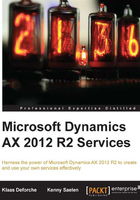
Bindings
When a client and service communicate, there are several aspects to the communication.
- Synchronous/asynchronous: Messages can be used in a request/response pattern or they can be used in asynchronous communication depending on whether the client waits for the response or not.
- Transport protocol: The protocol used for transporting the messages can vary depending on the needs. Protocols such as HTTP, Transmission Control Protocol (TCP), Microsoft Message Queuing (MSMQ), and Inter-process communication (IPC) can be used.
- Encoding: You have a choice on how to encode the messages. You can choose to use plain text if you want maximum interoperability. Alternatively, you can use binary encoding to speed up performance, or using the Message Transport Optimization Mechanism (MTOM) to handle larger payloads.
- Security: There are also some options that can be used to handle security and authentication. Security can be implemented at the transport level, at the message level, or can be skipped altogether.
As you can imagine, keeping track of all of the options can be a little difficult, and making the right choice on how to configure the different settings is not easy. To solve this, WCF introduces bindings. A binding is merely a grouping of choices that deal with each aspect of the communication that we just discussed.
WCF supports several bindings out of the box. If these do not suffice, there is always the alternative of creating a custom binding of your own. The following are the most commonly used bindings:
NetTcpBinding: This uses the TCP protocol and is mainly used for cross-machine communication over an intranet. It is WCF-optimized and thus requires both the client and the server to use WCF.BasicHttpBinding: This binding is used to expose a service as an ASMX web service so that older clients that comply with WS-I Basic Profile 1.1 are supported.WsHttpBinding: This binding is used for communication over the Internet. It uses the HTTP and HTTPS protocols and complies withWS-*standards. So, any party that supports theWS-*standards is able to communicate with the service.NetMsmqBinding: This type of binding will be used when support is needed for MSMQ queues. TheNetMsmqBindingbinding is actually a compact binding that does not provide all of the possible options to configure MSMQ. There are other bindings that provide more options.
Now that we have elaborated on some of the out-of-the-box bindings, you are probably asking yourself, how can I make sure I'm using the appropriate binding for my scenario? Well, the following flowchart may help you with this choice:
